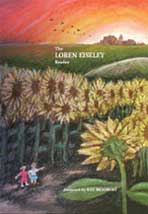Loren Eiseley: "The Night Country" Book review
Deb Derrick
Book Review – “The Night Country”
There are places where wild prairie grasses grow next to manicured landscapes, where barbed wire fences separate the sunflower forests from man’s concrete creations. There are places at the seam of the land, at the borders of our own landscapes, where the differences between night and day, wilderness and civilization, and nature and culture are blurred. In these border places, it is no man’s land.
Loren Eiseley, a literary naturalist and anthropologist, knows these places. As he writes in the opening chapter of The Night Country,
Along the uneasy border the old life of the wild has come back into its own. Weeds grow and animals slip about in the night where no man dares to hunt them. A thin uncertain line fringes the edge of oppression. The freedom it contains is fit only for birds and floating thistledown or a wandering fox (3).
The wandering fox, Eiseley’s alter ego, travels these borders in the pages of The Night Country, exploring the darkness and the shadows of his inner and outer landscapes. “Though I sit in a warm room beneath a lamp as I arrange these pieces, my thoughts are all of night, of outer cold and inner darkness” (xvii). Eiseley is at home in the dark—comfortable with occupying the borderlands that offer solace and easy escape, with no commitment or permanence required.
Noise is the Outside…Noise is all the things you did not wish to do…Noise is day. And out of that intolerable sunlight your one purpose has been given—to escape (4-5).
In succeeding chapters of The Night Country, Eiseley shares with us his journeys through cellars, caves and sewers with his friend whom he calls “the Rat,” whose face “had the quivering eagerness of some small, quick animal (19).
I loved the darkness. I feared it, yet returned to it. It was the mother out of which I came…It invited me forward. It urged me to crawl on (27).
Our war with the darkness began when man first lit a fire, Eiseley argues, and since then we have feared the darkness, unlike our nocturnal ancestors. In the dark, creatures with owl eyes and long tails lurk. The illumination of street lights is far away on the lonely plains with looming blue herons and shadows of range cattle. What terror these shadows cause us!
Sometimes in a country lane at midnight you can sense their eyes upon you—the eyes that by daylight may be the vacuous protuberant orbs of grazing cattle or the good brown eyes of farm dogs. But there, in the midnight lane, they draw off from you or silently watch you pass from their hidden coverts in the hedgerows. They are back in a secret world from which man has been shut out, and they want no truck with him after nightfall. Perhaps it is because of this that more and more we employ machines with lights and great noise to rush by these watchful shadows. (37)
Yet we grapple with our own shadows, and those shadows are darker than any of those we encounter on the Outside. Man is his own worst enemy. As Eiseley writes, “The mind inside us is vaster than the world outside…” (42). Our fears of wild places and uncharted futures drives us to an increasing frenzy toward control. We live increasingly in the future, assuming there will be a future that includes humankind. But we forget that the present is still evolving.
Nature…is never quite where we see it. It is a becoming as well as a passing, but the becoming is both within and without our power (54).
Every ruined civilization leaves its mark on the landscape, like paw prints on the newly cemented sidewalk. We humans are shadows ourselves on the entire continuum of time and space. We are alone in the universe; there is no one else with whom to share our wisdom and knowledge. We seek to locate ourselves in time by hanging onto old letters and photographs, making meaning of our existence but never resolving the paradoxes. Who are we? Where are we? Why? Most of us do not know where we belong. Our loneliness and madness may be our civilization’s downfall, Eiseley concludes, but perhaps the light will remain and we will survive after all.
At the end of The Night Country, Eiseley himself comes to experience those implications. He journeys back to a land of his childhood, looking for a cottonwood tree that he and his father had planted on the prairie. The tree had been there for sixty years, or so he thought. But as he discovers, the tree is not there, at least in physical form.
In sixty years the house and street had rotted out of my mind. But the tree, the tree that no longer was, that had perished in its first season, bloomed on in my individual mind, unblemished as my father’s words. “We’ll plant a tree here, son, and we’re not going to move any more. And when you’re an old, old man you can sit under it and think how we planted it here, you and me together” (235-236).



